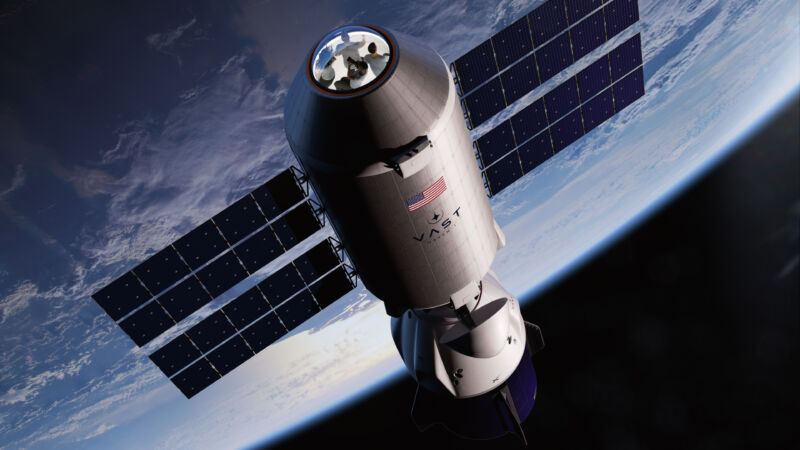
Wide
A private space station company, VAST, announced on Wednesday that it intends to launch a commercial space station by August 2025. After this “Haven-1” space station is deployed in low-Earth orbit, four commercial astronauts will launch to the facility. Aboard SpaceX’s Crew Dragon vehicle.
The California-based company said the crew will spend about 30 days on the Haven-1 space station before returning to Earth later. As part of Wednesday’s announcement, Vast said four of those crew seats are now ready for sale, as well as a second mission for a launch no earlier than 2026.
“It’s a super aggressive schedule,” Jed McCaleb, founder of Vast, said in an Ars interview. “But we have a clear path for how we’re going to get there.”
Getting into orbit fast
McCaleb founded VAST in 2021 to develop the world’s first space station with artificial gravity. The company’s plans are ambitious, and launching a habitable space station by 2025 represents a remarkably fast development time indeed.
Vast has some credibility, however, because McCaleb has money to pump into the company and has signed on several key technical advisors who had long careers at SpaceX, including Hans Koenigsmann, Will Heltsley and Yang Li. An early pioneer in blockchain technology, McCaleb created the first major bitcoin exchange, Mount Gox. Forbes estimates that he is worth $2.4 billion and has pledged to invest more than $300 million in space as he seeks to develop space stations.
A partnership with SpaceX is key to making this mission possible. The Crew Dragon spacecraft will not only launch the 3.8-meter-wide Haven-1 module aboard a Falcon 9 rocket, but also provide part of the vehicle’s life-support systems when docked.
The Dragon spacecraft is powered the entire time it is attached to Haven-1, providing certain consumables such as air or water and other services needed to keep humans alive. By leaning on its experience developing these life support systems for SpaceX and Dragon, Vast seeks to develop the space station on an accelerated timeline.
McCaleb said the program has support from leadership at SpaceX—important because that company devotes much of its time and energy to developing the next-generation Starship rocket.
“A commercial rocket launching a commercial spacecraft with commercial astronauts to the commercial space station is the future of low-Earth orbit, and with Vast, we’re taking another step toward making that future a reality,” said senior vice president Tom Ochinero. of commercial business at SpaceX, in a statement. “The SpaceX team could not be more excited to launch Vast’s Haven-1 and support the pursuit of human spaceflight to an orbiting commercial space station.”
Doing so safely
For crew safety, VAST intends to launch the space station into a 500-km orbit at the same incline as the International Space Station. There, the module is tested for a few weeks to make sure everything is working. The first crew will then launch to Haven-1 and if there are any problems during the stay, the Dragon will immediately be ready to depart.
Vast’s announcement comes as NASA hopes that private companies will begin housing its astronauts in low-Earth orbit. The space agency plans to decommission the aging International Space Station by about 2030, after which the agency plans to lease crew time at commercial space stations.
Currently, NASA is funding the development of four commercial space stations in low-Earth orbit; The stations are being built by Axiom Space, Blue Origin, NanoRocks and Northrop Grumman. All four of these stations remain in the design or preliminary development stages and all face questions about funding, commitment or technology challenges.
In short, the competition remains open and other entrants have time to secure NASA funding in future years for commercial space stations.

Wide
Vast intends to go after some of this funding, and it potentially has some advantages over the competition. A station with artificial gravity may have some appeal to NASA, and McCaleb has deeper pockets than other ventures outside of Blue Origin, backed by Amazon founder Jeff Bezos.
To meet NASA’s needs, Vast plans to launch a larger “starship-class module” by 2028. It will be nearly twice the size of Haven-1, which is seven-meters in diameter, and will be launched on SpaceX’s Starship rocket. (The modules of the International Space Station are 4.2 meters in diameter.) VAST has published a roadmap for its plans through 2040.
McCaleb chose Vast to start with the small Haven-1 station so that it could quickly begin flying on proven SpaceX rockets and demonstrate to its customers and NASA the viability of its hardware in real flight-like conditions.
The company is also planning some artificial gravity experiments on Haven-1 — which will be able to reach roughly the moon’s gravity, or about one-sixth that of Earth. It hopes for a more robust artificial gravity setup with the Starship Module later this decade.
#Vast #launch #space #station #Falcon
